Cardinal,Grosbeak,Finch breeding in Hungary
IF YOU ARE INTERESTED IN THIS TOPIC, LET'S CONTACT
Cardinals species I have
The Red-Cardinal finch (Richmondena cardinalis,Cardinalis cardinalis)
Class:Aves
Order:Passeriformes
Family:Cardinalidae
Genus:Cardinalis
Species: C. cardinalis
Of South American Cardinals the members of Paroaria genus got from Emberizidae family to Thraupinae family. It has turned out that they show closer relation to Tanagers family than Emberizidae according to molecular biologic and genetical tests.
http://jboyd.net/Taxo/List32.html
This new ordering only for the South American Cardinals, the northern species belong to Cardinalidae family.
Three species of Cardinalis genus:
http://en.wikipedia.org/wiki/Cardinal_%28bird%29
1.Northern Cardinal (Cardinalis cardinalis)
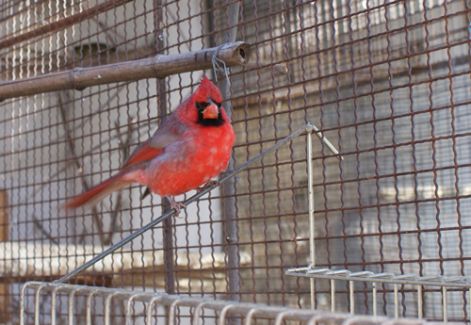
It is my male
2.Pyrrhuloxia/Desert Cardinals,Cardinalis sinuatus
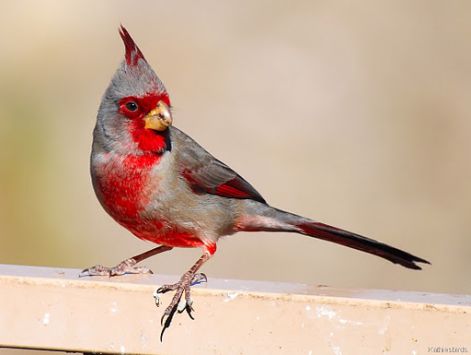
3.Vermilion Cardinals, Cardinalis phoenicus
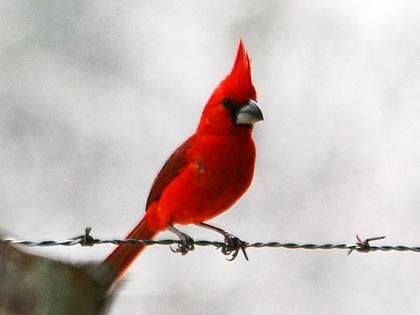
The Northern/Red-Cardinal is the most frequent of Cardinals species in Northern America. This is the species which represents all the features characteristic of the three species in North America. The difference in colours between male and female birds(sex dimorfism) is important in all the three species. The maleshave a bright red colour, the females' colour is not bright at all. Some English articles describe them as "mouse-colour". It is cinnamon-brown with darker, lighter shades. These robust seedeater finches are of strong beak (Grosbeak) that's why they can be classified into Coccothraustes. The whole group (Cardinalidae) is often mentioned as Grosbeaks because of the beak-form common in their appearance. It is true for the South-American grosbeaks too. The biggest finches belong to this group, sized 12-25 cms.
The Red-Cardinal is often called Virginian nightingale. Its voice is wonderful, but is can't be compared to the singing of our (Hungarian) nightingale. Its songs are more various.There is difference between the "performances" of Red-Cardinals, in variety and frequency. Red-Cardinals have an "open" genetic programme, which means that ability of singing is partly determined, partly learned.
It is known that singing birds reserve a territory for their reproduction by singing, which territory is called "revier". Cardinals, in general, are determined to defend their territory, but it is more valid in Red-Cardinals. In these periods of time they can't be put together with any other species. As I could observe, the dominant male send signals to other male warning them of the engaged territory. His singing sounds fascinating. The other males remain more modest. In nature everything is different. There is no need for ranking so much because each male has got a territory big enough for him.
In spite of the cold they are native and don't migrate from Canada and from the North of the USA. They are popular with the Americans, they are fedin winter. We can see them in Christmas greetings.
In captivity they don't mind the cold either and already begin to sing in December. Naturally, this singing is not so active, they don't chase the female yet.
Here in Hungary only the Red-Cardinal can be found of the three North-American species. C. phoeniceus and C. sinuatus are rare even in Western-Europe.
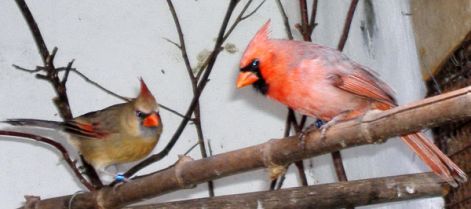
The breedind pair
Feeding of Red-Cardinals: popular articles recommend seeds, berries and insects as essential food. Even if we extend the offer we can't imitate natural diet. The question is the aim: to keep them or breed.
I got my first Red-Cardinals (3 males and 1 female) in the 1970's. They were imported. Unfortunately the only female couldn't survive the period of adaptation, died. I sold the males. Adaptation is always crucial, once they can survive it, they can live long.
Mixture of weed-seeds and -during breeding- insects of small size are suitable. Succesful breeding depends on a lot of different factors, which I write about in another chapter.(bringing up chikens)
In winter Blattner III can be given to them in itself but in the period of breeding a mixture of weed-seeds must be added. All in all, we must try to imitate their natural diet picking seasonal weed-seeds, berries, fruit and small insects in our environment.
Detailed information about feeding and available plants can be found:
http://serinus.forumx.hu
Placement:
Though they are not savage they didn't like living in a cage I offered. They prefer bigger cages: 3mX1,7mx0,8m is the size of the cage I keep them and they have already had young ones many times here. I leave them here in winter too, without any special shelter. Fresh drinking water is very important! On frosty days they get some black sunflower, walnuts, pumpkin-seeds also in addition to their usual seed mixture to provide some extra calory. Hempseeds should be avoided in winter as it makes the birds too active, sometimes agressive.
Bringing up chiks:
In their habitat in Canada they hatch once a year, in south of Canada 2-3 times a year.
I also have had three hatches a year but not all of the chicken grew up. Success depends on the parents and a lot of different things. The number of the eggs in generally 3 but it can be 4-5 depending on the condition of the female. On my "farm" there have been an unexpected 4th hatch with 2 eggs.
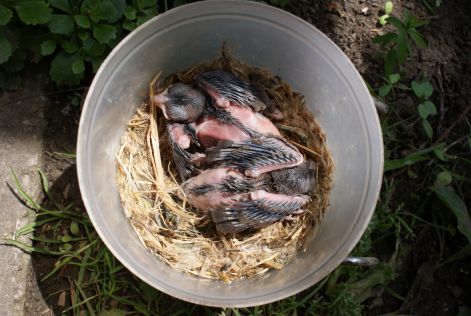
The chiks are 4-5 days old
In a case like that the nest must be taken away or else the female may got ill and die. At flying out they move uncertainly, and they are depending. They are able to fly up to their perching only 4-5 days after flying out. Then it takes more 20 days until they get independent. At the time of bringing up the chicken the parents get insect-eaters, in lack of insects they throw the chickens out of the nest.
They favourite live-food is: ant-eggs,fly-larvae, mealworms, grasshoppers. This time the males may get too active making the females nest earlier than the normal. (the males don't wait the chicks to get independent)
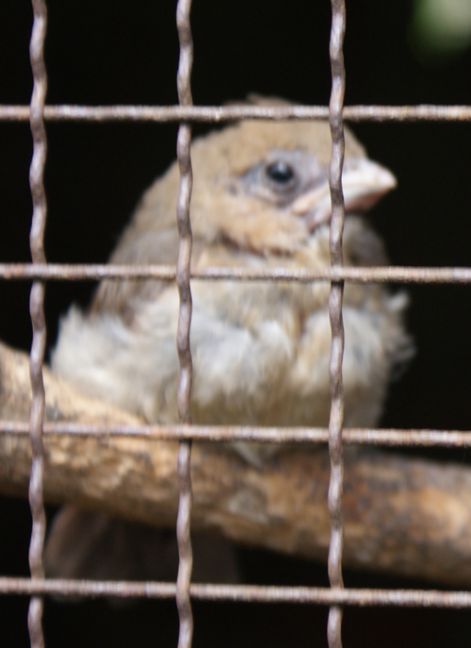
The chick is 15 days old
If you are have brave you can involve by handfeeding, begin it after their 5-6th days. Be aware of the fact that is a hard job.
The first moulting is critical. This time their condition is crucial, and remember to colour the young males. I use Cantax and red grapes.
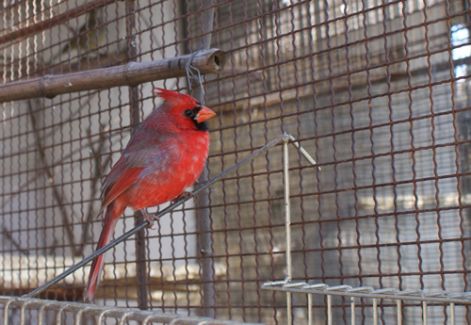
The male above in the photo got only red-grapes.
Red-Cardinals are getting more and more popular, their price is lower.
They are available in the western market. If you like challanges, you must have them.
Red-crested Cardinal (Paroaria coronata)
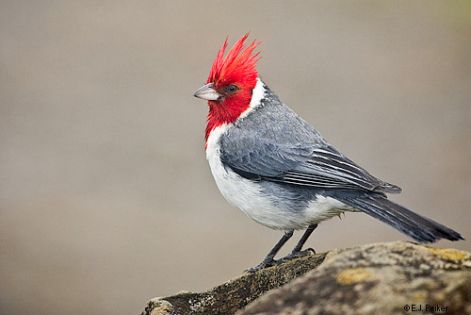
I have bred or have been trying to breed Cardinals. I must admit frankly that I have not had so many failures with other kind of birds as with cardinals. But if you are really devoted, you can't help trying. Well, I am one of the type. It is difficult to set up a harmonising pair because of the following causes:
1.Their prices
In Reggio-Emilia, Italy, at a bird-show a pair of Grey Cardinals costs Eu 450. In Italy they are always 30-40 % more expensive than in Holland though they are not so nice at all.
2.Low number of them
Once it occured that I wasn't able to get a female to my male Red-Cardinal.
3.Difficulty in seting up the right ratio of livefood during fledging
In general, they can fledge completely only one bird per nest or rarely two. They are savage and suspicious but beautiful. In 2007 I had three, this year four birds from one nest but it is not typical.
Their habitat: Northern Argentína, Bolivia, southern Brazil, Paraguay and Uruguay. Dry, sub-tropic or tropic, bushy habitat is suitable for them. Pantanal is a region like this.
Their general characteristics:
Length: 20 cm
In colour there is no difference between male and female.The back and the wings are dark gray. The neck and the abdominal parts are whyte.
The head, the crest and the upper part of the breast are bright red.
The beak is silver-grey and the legs are dark grey. There is no difference
in colour between the male and female but female's red colour is a little bit pale.
Juvenile: they are similar to the adult specimens but their head and the upper part of the brest are brown until the first moulting.
Their beak and legs are dark grey just like the adults'
Grey Cardinal chick of 5 days
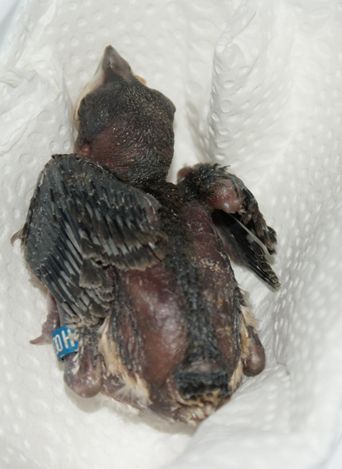
Ring size: 3.5 mm ring was used
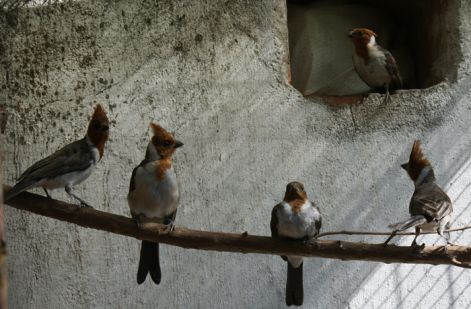
Young Grey Cardinals 2011 (They were bred by me)
They were the first species I had and bred. I saw them first at a breeder in 1971. Since then they have been my lifelong passion. I bought them but I couldn't breed them. Perhaps they were wild-caught, impoted from Germany.
Later, in 1972 I bought another pair and they had a chick.
Feeding: millet, canary seed, oats mixture.
It was difficult to get any information about their feeding. I could get ant eggs to feed the first chicks but as it wasn't regular only one chick could survive.
They don't like eggfood very much, they eat only a litle of germinated seeds during the incubation period. The parents prefer insects mainly in fledging. They indicate the lack of insects by throwing the chicken out of the nest. They can't stand ringing, which can be another cause of throwing the chicken out.
The most important part of fledging is the great variety of insect- food, changing in size. "Field plankton"(grass networked insects) would be the best but it is impossible to collect them in such a big amount.
According to experts these birds can live for 20 years.The typical problem is agression caused by worminess and coccidiosis. We must be careful about canary seed because it is very fattening.
They must be given vitamins twice a week. Termite ant puppets or mealworms can be fed to them. Besides them I feed mourning beetle larvae, pinky, house fly larvae.
Placement: a cage of 80X40X30 cm, the nest: 12 cm diameter 6 cm deep.
I, personally, prefere voliers with evergreen plants.
The jungs fly out of the nest at the age of 10 days. At this age they can hardly fly, they crawl rather than fly. "The pablic enemy number one" is rainy weather and cold. That's why I recommend a covered volier. If a chick gets a cold, doesn't ask its parents for food, the parents think that the baby isn't hungry and they don't feed it. For instance in 2009 a whole clutch perished in cold rainy weather. If they have survived 4-5 days ofter flying out, they are strong enough to follow the parents.
At the age of 35 days they are separeted, it means that they are independent from parents. During fledging we must be careful about livefood. If the male takes in too much of it he gets agressive making the female begin a new start.
http://www.criadourobutia.com/index.html
Red-capped Cardinal (Paroaria gularis)
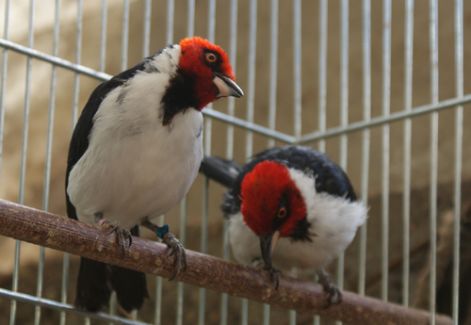
Yellow-billed Cardinal (Paroaria capitata)
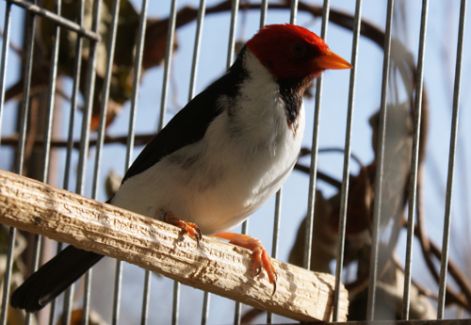
Black-crested Finch or Bolivian Cardinal (Lophospingus pusillus)
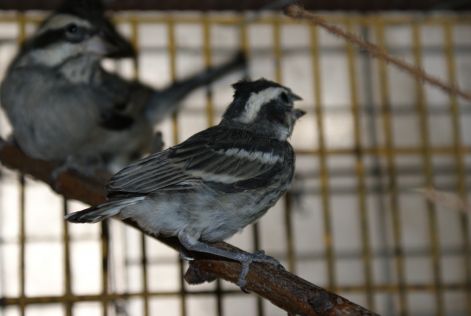
Yellow Cardinal (Gubernatrix cristata)
As for the name, in its English name it is "yellow", in the German name is "green".
In Hungarian it is also "green".
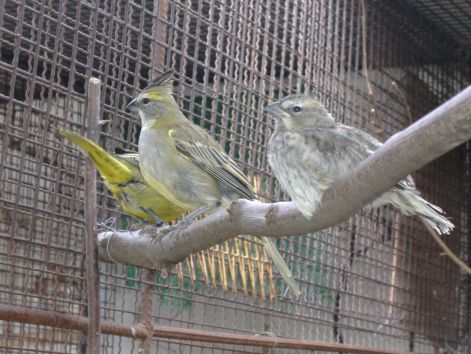
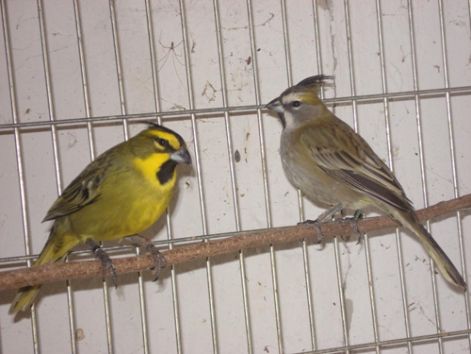
Birds breeding for years
Outside their breeding period they can be placed together with other species without any problems. Even this time we must watch out whether they quarel or not. Earlier on my farm they spent the winter outside , but recently I have taken them into a dry shelter where the temperature is about +10 C. They are popular although they are not so colourful as Red/Red-Crested. I have experienced that the Yellow Cardinals are more humble, nicer and they don't mind checking the nest.
Description:
Size: 20 cm
Male: olive body with black stripes, yellow face and throath, the crest and the patch on throat is black, the abdomen is yellowish-green. The beak is dark- grey, legs are dark grey also.
Female: The body is greyish-green and greyish-white. Its beak and leggs are the same colour as the males'. The young ones have the colour of the female's and the young males get yellow only in second year.
Feeding:seed -eater
In the mixture there is canary seed, millet mix (white,yellow,red) oats, hempseed,rice. They like the fruit of the actual season. I give them mainly apple every day in winter. They need more fresh vegetables and half-riped seeds than Grey and Red Cardinals. The latters are insect-eaters during bringing up chicks but Yellow Cardinals like fresh vegetables besides insects in this period. During hatching they need livefood: anteggs, pinky, mealworms.
Breeding:
I take them outside into a volier, size of 3 m x 1,75 m x 0,8 m. They don't mind smaller places either. I give them a nest when the male begins singing regularly especially erly in the morning. The song is not too variable, it is rather a strong clapping, which means territorial behaviour too. They get a simple nest in April.
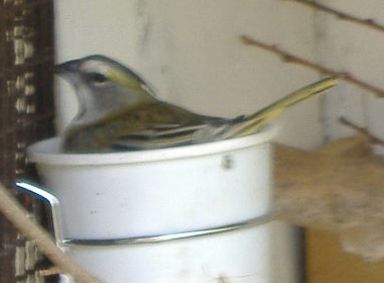
Female in the nest
The number of the eggs is 3-4-5
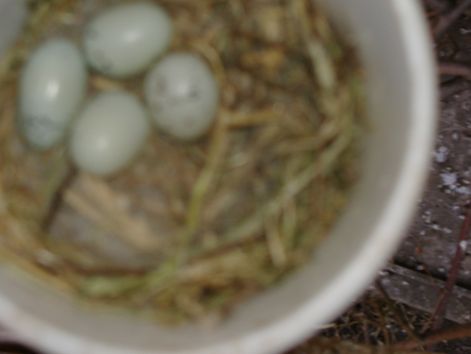
Eggs of a Yellow Cardinal
Sometimes there are a lot of empty eggs, the cause is still unknown for me. It may be caused by:
1.Too early pairing
2.The lack of sexual intrest
3.Overweight male
Hatching: after 12-13 days
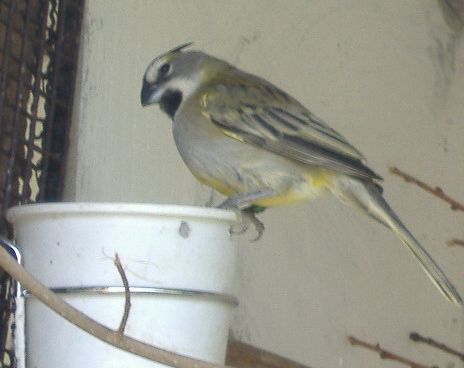
The female with chicks
Feeding livefood in the first days is essential. They are ringed (3,5 mm) on 5th day. Both the male and female feed from the beginning,the chicks grow fast.
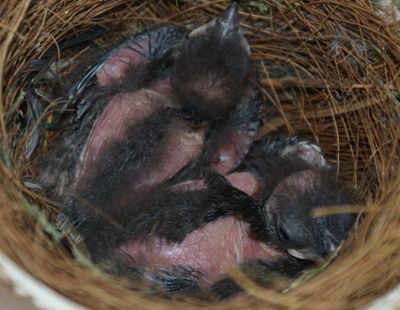
7-8-day chicks, they leave the nest on 11-12th days.
The parents like sprouted seeds and fresh vegetables, weeds. Weather conditions can be crucial in first week.
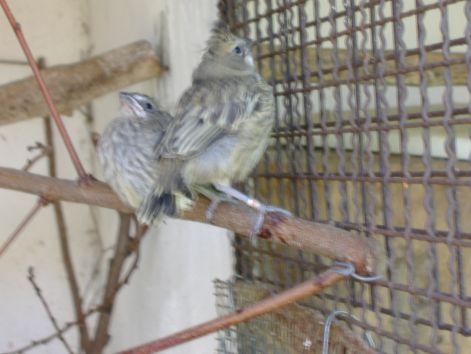
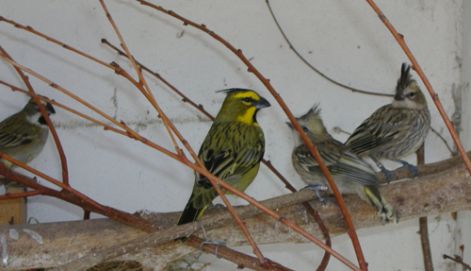
Parents and their chicks
After leaving the nest the young males must be watched if their father attacks them. It can be fatal. They get independent at 35 days, they must be separated.
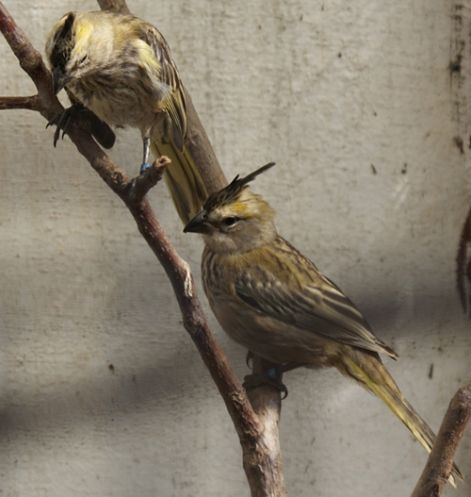
A volier with young cardinals in autumn
Weedseeds are the most important food at moulting. At the end Oktober, at the beginning of November they get into a birdroom.
In western European countries they are widespread. In their habitat (South America) their population is decreasing. They deserve more care.
Paroaria dominicana. I bought 1 pair of Red-cowled Cardinal in Meppel.12.02.2011.
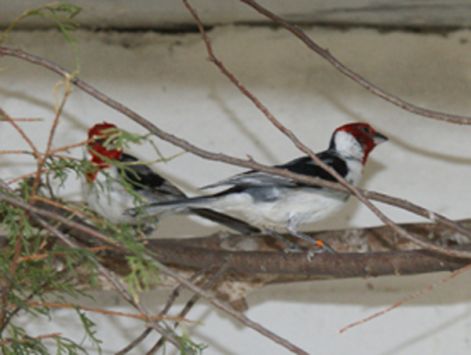
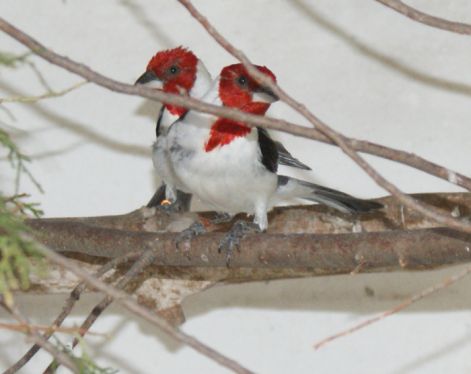
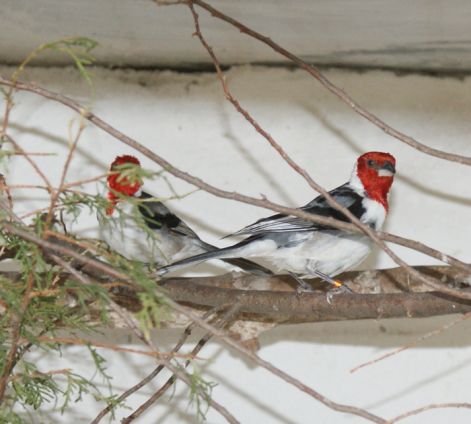
New species in 2013:
1.I bought a pair of Vermilion Cardinal(Cardinalis phoenisu), the female died during transport. I looking for a not captured (bred) female.
2.I bought a pair of Paroaria nigrigenis in Belgium. They haven't in full color.
After taking photos of them, you can see here.
Honlapkészítés ingyen:
Ez a weblapszerkesztő alkalmas
ingyen weboldal,
ingyen honlap készítés...
Mai: 55
Tegnapi: 61
Heti: 55
Havi: 1 937
Össz.: 176 189
Látogatottság növelés
Cardinal,Grosbeak,Finch breeding in Hungary - © 2008 - 2025 - kardinals.hupont.hu
